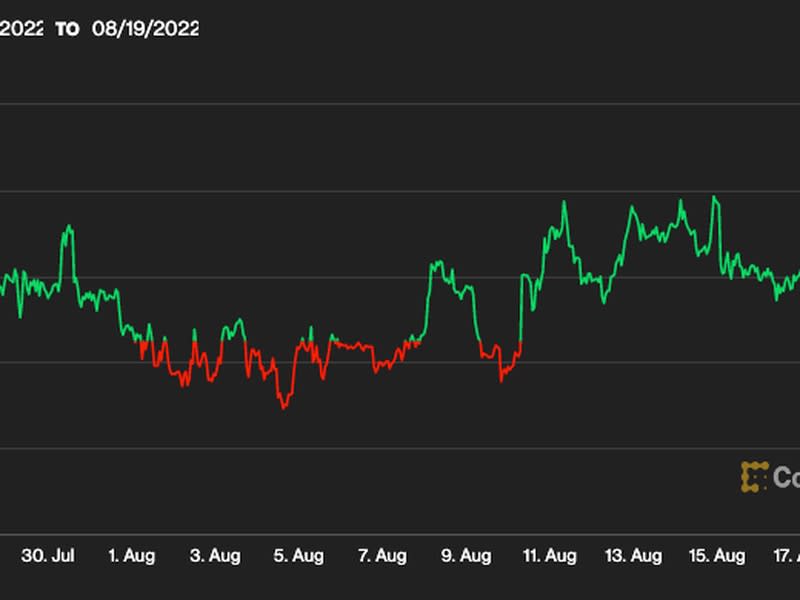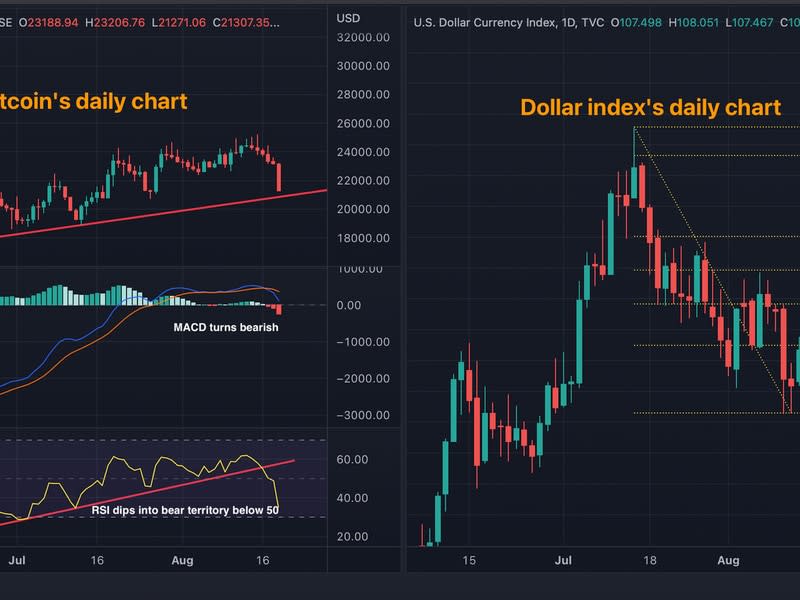First Mover Americas: Fear Returns to Crypto Markets as Bitcoin Plunges Most in 2 Months
Price Point: After almost reaching highs of $25,000 earlier this week, bitcoin has dropped to $21,400, and crypto traders suffered $600 million of liquidations of leveraged bets because of margin calls.
Market Moves: Is Filecoin network's incentive plan sustainable? CoinDesk's Jimmy He dives in.
Chart of The Day: The U.S. dollar strength weighs over bitcoin.
This article originally appeared in First Mover, CoinDesk’s daily newsletter putting the latest moves in crypto markets in context. Subscribe to get it in your inbox every day.
Price point
Bitcoin (BTC) plunged the most in two months, falling in sync with traditional markets amid renewed fears that the Federal Reserve and other central banks will become more aggressive in fighting inflation.
The move brought a decisive end to hopes in the past month that the world’s largest cryptocurrency might stage a recovery following the price crash in May and June.
The price has tumbled 9.3% over the past 24 hours to about $21,400, just days after crypto analysts had been salivating over the prospect of a push past $25,000.

According to Coinglass, crypto traders had $600 million of liquidations of leveraged bets because of margin calls.
Ether (ETH), the second-biggest cryptocurrency, which had gained in recent weeks from ebullience ahead of an upcoming software update on the Ethereum blockchain known as the Merge, fell 9%.
“The crypto winter may not be over yet,” with a drop toward $20,000 now possible, Oanda analyst Craig Erlam said.
Some altcoins took a larger dive, with Filecoin’s FIL token down 17% and Ethereum Classic’s ETC down 15%.
Cryptocurrency-related stocks were trading significantly lower in Friday’s premarket session, CoinDesk’s Oliver Knight reports. Marathon Digital (MARA) and Riot Blockchain (RIOT) were leading the plunge, with both sliding by double-digit percentages.
Shares of crypto exchange Coinbase (COIN) were down about 7% to $77.81, and shares of MicroStrategy (MSTR), a software company that holds a large amount of bitcoin, were down 8.2% to $297.68.
In the news, a new Galaxy Digital Holdings' crypto fund is on path to raise $100 million by the end of the year. The crypto merchant bank's Liquid Alpha Fund launched last quarter with internal capital.
Biggest Gainers
There are no gainers in CoinDesk 20 today.
Biggest Losers
Asset | Ticker | Returns | DACS Sector |
|---|---|---|---|
Gala | −15.5% | ||
Dogecoin | −15.0% | ||
Terra | −14.4% |
Market Moves
Is Filecoin Network's Incentive Plan Sustainable? Crypto Analysts Want to Know
By Jimmy He
How long can it last?
That's what crypto analysts are wondering about the Filecoin incentive program, the driver behind the bulk of the blockchain project's growth.
Filecoin was launched in 2020 to decentralize the data-storage business, providing an alternative to industry giants like Amazon Web Services at nearly a thousandth of the cost.
At its core, the network connects storage providers with clients looking to stow their data. By offering storage space – ranging from extra capacity on desktop computers to large racks – and then running mathematical proofs to show that clients’ data is unaltered, providers can earn the network’s native FIL token as a blockchain reward.
Recently, activity has soared. According to a Messari report, active Filecoin storage deals between providers and clients surged 128% to the second quarter from the first quarter.
That has crypto analysts calling attention to the incentive program linked to almost of that growth – Filecoin Plus (Fil+) – and wondering whether it's sustainable.
Under Fil+, storage providers can earn 10 times the block reward, or number of FIL tokens, of a typical deal by working with “trustworthy clients” such as universities and research facilities. Those clients apply to notaries, or community-elected trustees, to verify the data they are storing.
Fil+’s approval system weeds out storage providers that may negotiate deals with clients storing fake data just to reap block rewards.
Analysts say that Fil+ block rewards act as a subsidy for providers, making it feasible for them to slash storage fees (averaging $0.0000026 per gigabyte per year). Still, they wonder what might happen to Filecoin’s growth and activity once the incentive program tapers off.
“Over time, storage miners will have to start charging,” Messari research analyst Sami Kassab said. “What I think is going to be the most important thing to watch there is if the storage demand can still keep up when storing data is no longer free.”
New revenue streams
Filecoin project leaders say the network is set to roll out new functions to create additional revenue streams for data-storage providers, which would maintain growth and keep prices low even as the extra block rewards decrease.
Jonathan Victor, product lead for Protocol Labs, the open-source research and development lab that developed Filecoin, outlined five revenue sources for storage providers, including block rewards, storage fees, retrieval fees, transaction fees and additional services.
Storage fees are what clients pay storage providers for the initial storage deal. Retrieval fees are what clients pay providers to fetch stored data. Transaction fees are what crypto brokers charge traders for buying and selling FIL.
While revenue from block rewards will eventually decrease, Victor argues that storage fees will remain low as long as providers can make up the lost revenue through retrieval fees, transaction fees and additional services.
According to Filecoin’s 2022 road map, the storage network plans to add a retrieval market during the third quarter that would increase the speed of blockchain data retrieval and allow storage providers to charge clients for retrieving the data they are storing.
Filecoin also launched the Filecoin Virtual Machine (FVM) in July, which let clients run smart contracts from other networks and unlocked the potential for decentralized finance (DeFi).
Filecoin plans to implement a programmable storage market in the fourth quarter. That would allow clients to create customized smart contracts to meet their needs.
“Things like the FVM are going to drive transaction fees,” Victor said. “It will drive demand for Filecoin block space.”
Read the full story here.
Chart of the Day
Dollar Strength Weighs Over Bitcoin
By Omkar Godbole

Bitcoin is fast approaching support of trendline connecting July 18 and July 13 lows with the dollar index rising past the widely tracked 61.8% Fibonacci retracement.
Bitcoin's technical indicators – the RSI (relative strength index) and the MACD (moving average convergence/divergence) – suggest there could be more pain ahead.
Latest Headlines
World's Biggest Companies Invested $6B in Blockchain Firms September-June, According to a Blockdata Study: Google parent Alphabet participated in four funding rounds that raised a total $1.5 billion, Blockdata found.
Crypto Reverses CPI-Induced Rally as Bitcoin Slides Below $22K: The leading cryptocurrency by market cap fell to the lowest level since July 27 early Friday.
Crypto Lender Hodlnaut Faces Singapore Police ‘Actions’ and Staggering Job Cuts: The latest firm to freeze crypto withdrawals is engaged in “proceedings” with authorities.
Ripple Unveils Crypto On-Demand Liquidity Service in Brazil: Ripple is teaming up with the digital bank Travelex to introduce the product, which will initially allow transactions between Brazil and Mexico.
Crypto Lender Celsius' Collapse Into Bankruptcy Should Be Probed, US Says: Some of the highest-profile and controversial bankruptcies in history, including Enron and Lehman Brothers, have included the appointment of an independent examiner.

 Yahoo Movies
Yahoo Movies 